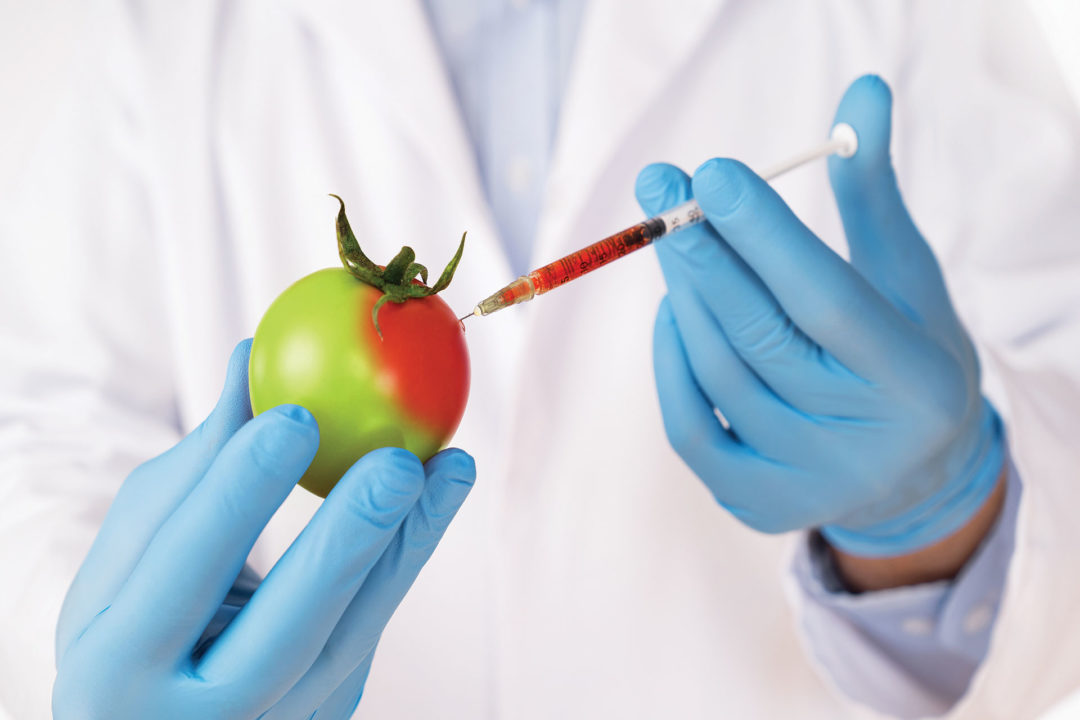One thing is clear: Consumers want to know whether or not a food contains GMOs. According to WholeFoods legal editor Scott C. Tips: “Most consumers want GM foods labeled. Consumer polls across the World have shown this to be true. In the United States alone, some 90% of consumers want such labeling (1).”
Adding more potential for consumer confusion: Instead of on-package labeling, manufacturers will be able to post ingredients online, accessable through QR codes, URLs or phone numbers, as the USDA wrote in the “BE Disclosure” document (2). Advocates argue that using online methods as “transparency” discriminates against millions of Americans who don’t have access to cell phones or cell service on a daily basis (3).
As consumers become aware that labels may not tell them which items on shelves do contain genetically modified material, they may increasingly seek out labeling that assures them that a product does not contain these ingredients. Indeed, today nearly 76% of Americans are familiar with the Non-GMO Project Verified seal that is displayed on thousands of products (4). In an article published by the Center for Food Safety, west coast director Rebecca Spector says: “Non-GMO verified labels remain the only dependable way to avoid GMOs.” Since the USDA has prohibited well-known terms like GE and GMO, food safety groups like the Non-GMO Project are vital.
On the point of labeling, Philip Siegel, COO of Seapoint Farms, asks, “What it comes down to is this: Does this help the consumer understand what they are buying, or is it confusing because there are different interpretations?” He believes the non-GMO investment is worthwhile for retailers and manufacturers. “Non-GMO has been a topic of increasing interest and is part of the growing trend of consumers taking a more active role in choosing foods that support a healthy lifestyle.”
As a 20 year veteran of the Non-GMO Project Verified seal, Seapoint gives consumers the assurance and confidence that if they are seeking products that are non-GMO, that is in fact what they are getting, Siegel said. “Going through the certification process to become non-GMO certified was a no-brainer for Seapoint because it was the natural step to prove and verify that our products are non-GMO.”
It is a similar story at Simply Protein. Jonathan Clinthorne, Ph.D., nutrition communications manager for the company, tells WholeFoods, “Our goal with Simply Protein has always been to provide as clean a product as possible, so it was a pretty simple decision to make sure we sourced non-GMO ingredients for all of our bars and crunchy bites.” In the end, he says, “it pays off by showing consumers that any of our products fit into the simple and clean lifestyle that they want. Whether you are just grabbing an afternoon snack or need a pick-me-up before a workout, consumers can count on the fact that any of our products will be non-GMO.”
The path to a Non-GMO Project certification is rocky but worth it, adds Lilly Miscoe, president of Lilly’s Foods. “They scrutinize to the last detail, but it’s really refreshing to see a firm so committed to making sure consumers get what they’re asking for.”
More companies are putting in that effort. FoodChain ID, a company that assists manufacturers and more through certification and technical and testing services and solutions, announced in December that it had received a record number of Non-GMO Project Verified product submissions. David Carter, general manager of FoodChain ID Technical Services, said in a press release that “New product submissions are an indicator that demand is up for companies interested in getting their products Non-GMO Project Verified. Greater demand is evidenced by FoodChain ID receiving over 1,000 new product submissions in the record month of November”(5). And Mark Cohen, senior director of marketing, told WholeFoods that the number is “significantly” higher than in previous months (5). “Verifications had been fairly steady all year,” he said. “This is a sudden jump.”
How many Americans buy non-GMO? Interest is up—but there’s also room to grow, new data from the Pew Research Center suggests (6). It’s a close call when it comes to whether Americans believe organic is better for them. According to the study, 51% of adults say that organic is neither better nor worse than conventionally grown produce.
Perhaps location plays a part in it. Casey Baesler, representing Baesler’s Market, a 120-year old market in Indiana, offers this perspective: “Being a small Midwest town, GMO has not become a priority.” She continues, “We have tried to educate our consumers for years about non-GMO products, but we really don’t have too many customers that seem to care about it.”
The belief that there’s no need to opt for non-GMO food may stem in part from the information Americans are getting from our government. The FDA said that foods from genetically engineered (GE) plants must meet the same food safety requirements as foods derived from traditionally bred plants and that GE plant varieties marketed to date are as safe as comparable, non-GE foods in their “Consumer Info About Food from Genetically Engineered Plants” article (7).
Mimicking that stance, the Academy of Nutrition and Dietetics shared a report completed by The Academy Positions Committee, the Evidence Based Practice Committee and the GMO Task Force. “While recognizing the inherent difficulty of detecting subtle or long-term effects in health or the environment, the study committee found no substantiated evidence of a difference in risks to human health between currently commercialized genetically engineered crops and conventionally bred crops, nor did it find conclusive cause-and-effect evidence of environmental problems from the GE crops” (8).
That said, a research team based out of Australia led by Judy Carman, Ph.D., shared a different perspective. “Of the few independent studies being done, a study by the Austrian Government recently found reduced fertility in mice fed GM corn,” Dr. Carman explained in the interview published by The Organic and Non-GMO Report. “Another study in Italy showed mice contracting immune system problems after consuming a diet filled with GM corn” (9). Therein lies the distrust.
“There remains a long-standing practice of ‘Don’t Ask Don’t Tell’ in the natural products industry regarding genetically engineered food and ingredients,” Julie Yeiter, marketing team manager at Eden Foods, told WholeFoods. “Most commonly, inquiries are deflected by saying that GMOs are ‘...not allowed in the USDA organic program...’”
Still, many in the industry are fighting to increase awareness about GMOs. A panel at Expo titled Insidious: How synthetic biology threatens your natural ingredient supply chain hosted by UNPA, Natural Grocers, Friends of the Earth, INFRA, Organic & Natural Health and Coalition for Supplement Sustainability, went in-depth into new ways crops are being stealthily bioengineered (such as gene editing and engineered insects)—and how industry groups are working to develop tests to identify impacted crops. INFRA president and CEO Corinne Shindelar issued a call to action. "INFRA has hosted a letter—a GMO statement used to inform because people have the right to know. But we aren’t doing enough to give people the right to know what’s in our food supply." She encouraged all to sign the letter, which can be found at www.naturalfoodretailers.net/gmo-statement.
Clearing up the confusion How can retailers best market non-GMO products to consumers that are mixed on the topic of organic health benefits? Joanne Walter, CMO of Smart Baking Company, suggests it’s in a retailer’s best interest to provide more shelf space for non-GMO products. Since food transparency is on the minds of consumers and manufacturers, Walter says, “In the health food space, our retail customers care as much about what we leave out of our products as they do about what we put in.”
Using non-GMO callouts on unit pricing tags is another way to help the consumer understand which manufacturers have gone the extra mile to provide transparency, says Doon Wintz, president of Wholly Wholesome. When retailers commit and invest in non-GMO products, their customers will know they are looking out for them, suggests Miscoe. By creating trust and support, she says, retailers can gain lifelong customers.
Sotherary Hom, marketing manager at NestFresh, explains how retailers can support their customers by becoming a Non-GMO Project Retailer. “Participants of the Non-GMO Project Retailer program receive recognition as a supporter, monthly newsletters, access to a retailer collateral platform, and other supportive and educational resources.” Hom says. “If retailers take advantage of the tools offered to them, they, too, can become a resource for their shoppers.”
Find more information on how to become a Non-GMO Project Retailer on www.nongmoproject.org/get-involved/retailers/home.
The future of food transparency Consumers continue to become more knowledgeable about organic and natural foods, and hundreds of companies continue to invest in third party certifications and verification processes to support food transparency. All of the manufacturers we spoke to expect consumers to demand more transparency from their manufacturers.
Manufacturers, like Eden Foods, have noticed a large spike in demand for their non-GMO foods and beverages. With more than 50 years in the industry—26 years being certified non-GMO— the company has developed trust with their consumers by participating in audit trails, meticulous record keeping for every food item and knowing their land and farmers. Consumers, they believe, are likely to gravitate towards companies that are transparent and open about their regular practices.
“In regards to transparency, unfortunately many consumers don’t trust that food manufacturers are being completely transparent so having third party verifications will likely become more important than FDA-approved label claims,” says Dr. Clinthorne.
“What I see,” Wintz says, “Is that much of the food industry will seek to block this movement, as it can be difficult, expensive and counter to commercial interests. At the end of the day, our view is that many of the ‘advances’ in food technology throughout history have benefitted the manufacturers more than the consumers.” He adds that as consumers are educated on the ever-expanding choices when it comes to food products, the “more educated” and savvier consumer will find ways to vote with their dollars and will put an increasing value on products, brands and companies that provide real transparency about what is in their food and how it is produced. WF
More to know on GMO
 This topic is often covered on www.WholeFoodsMagazine.com. For more background, read:
This topic is often covered on www.WholeFoodsMagazine.com. For more background, read:
“GMOs Then and Now” by Simi Summer, Ph.D., looks at the history of GMOs in our food supply and the impact GMOs are having on health.
“GMO Foods Will Soon Be Mislabeled As Biofortified” by Scott C. Tips discusses what Tips calls the agenda to sneak GMOs into our foods.
“USDA Issues Final Rule on National Bioengineered Food Disclosure Standard” gives an overview of the USDA rule, including implementation dates and industry reactions.
References- Scott C. Tips, “GMO Foods Will Soon be Labeled as Biofortified,” WholeFoods Magazine. Posted 1/25/19. Accessed 3/1/19. www.wholefoodsmagazine.com/columns/legal-tips/gmo-foods-will-soon-be-mislabeled-as-biofortified/
- USDA Agricultural Marketing Department, "BE Disclosure," Ams.usda.gov. Accessed 3/1/19.www.ams.usda.gov/rules-regulations/be
- Center for Food Safety Staff, "Long-Awaited Final Regulations for GMO Food Labeling Leave Millions of Americans in the Dark," Center for Food Safety. Posted 12/20/18. Accessed 2/15/19. www.centerforfoodsafety.org/press-releases/5487/long-awaited-final-regulations-for-gmo-food-labeling-leave-millions-of-americans-in-the-dark
- Ken Roseboro, "Report--nearly half of consumers avoid GMOs; more are buying non-GMO products," The Organic & Non-GMO Report. Posted 7/7/18. Accessed 2/8/19. www.non-gmoreport.com/articles/report-nearly-half-of-consumers-avoid-gmos-more-are-buying-non-gmo-products/
- WholeFoods Magazine Staff, "FoodChain ID Announces Record Number of Non-GMO Product Submissions," WholeFoodsMagazine.com. Posted 12/20/18. Accessed 2/15/19. www.wholefoodsmagazine.com/news/main-news/foodchain-id-announces-record-number-of-non-gmo-product-submissions/
- Mark Strauss, "Americans are divided over whether eating organic foods makes for better health," Pew Research Center. Posted 11/26/18. Accessed 2/8/19. www.pewresearch.org/fact-tank/2018/11/26/americans-are-divided-over-whether-eating-organic-foods-makes-for-better-health/
- USDA Staff, “Consumer Info About Food from Genetically Engineered Plants,” FDA.gov. Posted 1/4/18. Accessed 2/8/19. www.fda.gov/food/ingredientspackaginglabeling/geplants/ucm461805.htm
- The Academy of Nutrition and Dietitetics Staff, “Labeling of Bioengineered Food and Food Ingredients,” EatrightPRO.com. Posted 6/22/18. Accessed 2/15/19. www.eatrightpro.org/news-center/on-the-pulse-of-public-policy/from-the-hill/labeling-of-bioengineered-food-and-food-ingredients/
- Ken Roseboro, “GM Food Safety Testing is ‘Woefully’ inadequate,” The Organic & Non-GMO Report. Posted 1/2009. Accessed 2/8/19. www.non-gmoreport.com/articles/dec08/gm_food_safey_testing_inadequate.php










